
views
Using a Hand Line

Tie any hook you have available onto a piece of fishing line. Use an actual fishing hook, such as a barbed hook, or improvise a hook out of whatever you have available. Tie it to a piece of fishing line or to an improvised line.Tip: You can also tie a weight onto the line to help you cast it and let it sink in the water. In a situation where you don’t have a fishing weight, you could try to tie the line around a small rock. You can improvise a hook from many things such as paper clips, safety pins, sewing needles, and even soda can tabs. If you don’t have any actual fishing line, you can use thread from clothing, shoelaces, and vines or other sinewy plant material.

Bait the hook with your bait of choice or a fishing lure. Hook the bait or tie the lure onto the line. Use live bait, a store-bought bait or lure, or an improvised lure, depending on what you have available and what you want to catch. You can use live bait you find in the wild such as worms, minnows, and insects. To improvise a lure, you can use shiny metals or even colorful pieces of cloth. For example, worms work well for catching medium-large fish, such as bass, walleye, and trout. Powerbait is a store-bought alternative to worms for catching the same types of fish. Insects work well for catching smaller fish.
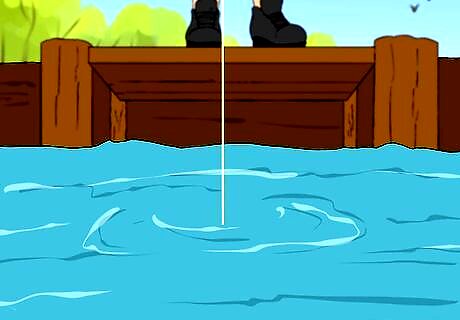
Drop the line into the water and let it sink. Stand on the shore, on the edge of a dock, or sit near the side of a boat. Cast the line out far enough that it won’t tangle on anything and let it sink and dangle in the water. Now you can either wait until you get a bite or slowly pull the line back in and repeat the process to try and attract fish. You might want to wear gloves to protect your hands from getting cut by the line.
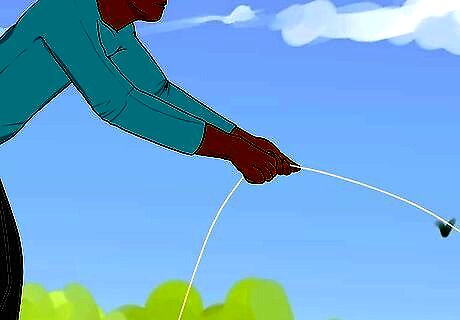
Tug on the line to set the hook when you get a bite, then pull the fish in. Give the line a sharp tug as soon as you feel a bite. This will hook the fish, then you can pull it in to you. Don’t ever wrap the line around your hand or any part of yourself. A big fish could cause the line to give you a nasty cut. To reel the line in, pull it in hand-over-hand. In other words, always hold on to it with 1 hand, then release it with the other hand, and put that hand in front of the hand holding it. Imagine that you are climbing a rope and repeat this process to reel it in. You can spool the line around a thick stick or a can to create an improvised reel and help you reel the line in more easily.
Making a Trap out of a Plastic Bottle
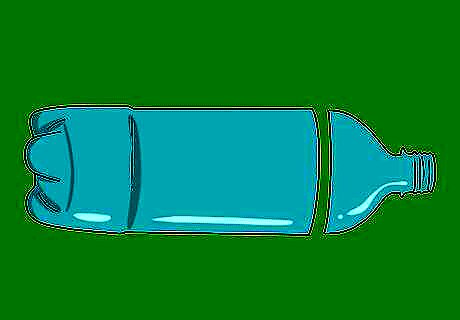
Cut the top off a plastic 2-liter bottle or another bottle with a funnel-shaped top. Use a sharp knife or scissors to cut off the cone-shaped part of the bottle. Any kind of plastic bottle will work for this. Take off any labels that you can remove from the bottle so that it is as clear as you can make it. This method will only catch fish that are small enough to fit inside the mouth of the bottle.
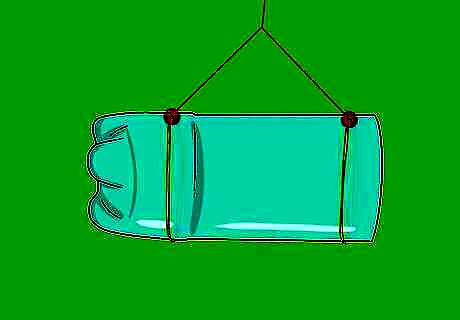
Tie a line on the bottle so that you can secure it once sunk. Poke 2 holes in 1 side of the bottle with the tip of a knife near the top and bottom. Thread a string or fishing line through the holes and tie it off. This will allow you to retrieve it from deeper waters, or to tie it to something to make sure it doesn’t float away. If you don’t have anything to tie to the bottle trap, then make sure you only use it in very shallow water where you can easily retrieve it.

Reinsert the funnel part upside down in the cylindrical part. Turn over the cone-shaped top part of the bottle that you cut off and stick it back in the bottom part. The mouth of the bottle will now be inside it. If you have a hot glue gun or duct tape available, you can use it to secure the pieces together.
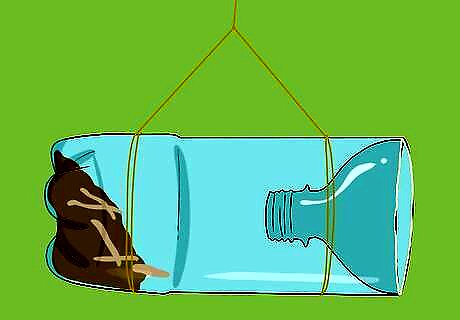
Place some bait and small stones in the bottle to sink it. Throw in a few pebbles so that the bottle will sit on the bottom of the water. Add bait like insects or any scraps of food you have for bait.Tip: You can use any food scraps available to catch small minnows. For example, crumbs of chips or crackers can work. Remember that this trap will only catch small fish, so smaller bait is better.
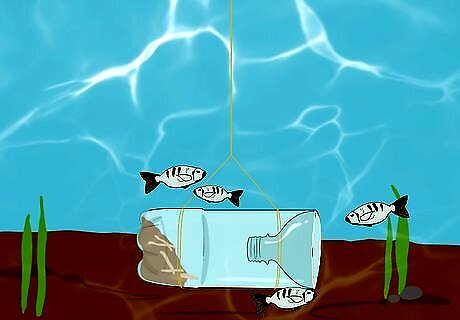
Drop the bottle in shallow water so it lays flat on the bottom. Place it carefully with your hands if the water is shallow enough, or drop it in and try to guide it with the line in deeper water. Position it so it is laying flat on its side with the funnel exposed. Hold onto the line or tie it to something, or watch the bottle carefully if you don't have any line so that you don’t lose it in any currents.
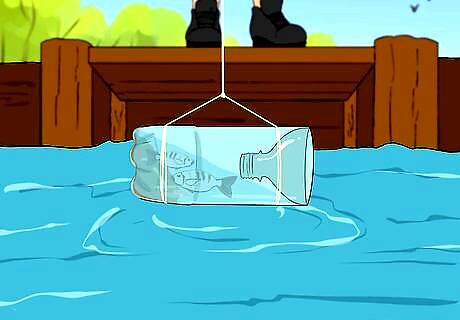
Pull the bottle in after 1-2 hours and see if any fish are trapped inside. Carefully tug the bottle in with the line or lift it out with your hands and look inside. Put it back in the water if there are no fish inside. To increase your odds of catching fish with this method, create several of these traps and place them in different areas.
Spearing Fish
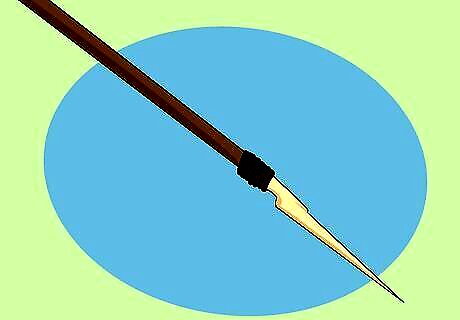
Buy a fishing spear or carve one out of a branch. Professional fishing spears are sold at most sporting goods stores. Find the straightest branch you can and carve the tip to a sharp point with a knife if you have to make a fishing spear. Green willow wood works best if you have to carve a spear, but any strong, straight branch will work. Try to find a branch with 2-3 prongs at the tip you can carve into a trident to snag fish more easily. If you buy a professional spear, you can even get one with a launching mechanism, like a speargun or a bow with fishing arrows. This method only works for catching large fish. It requires a lot of skill and patience.

Find a place on the shore to hide your silhouette from passing fish. Stand somewhere where any light won’t project your shadow onto the water. Your shadow will scare away fish and make it hard to spear any.Tip: Try to find a narrow, shallow spot where the fish are forced into when they pass by to increase your odds of spearing one. Pick a spot near shallow water where you will be able to easily spot fish as they pass by. You can also spear fish at night with a flashlight or headlamp.
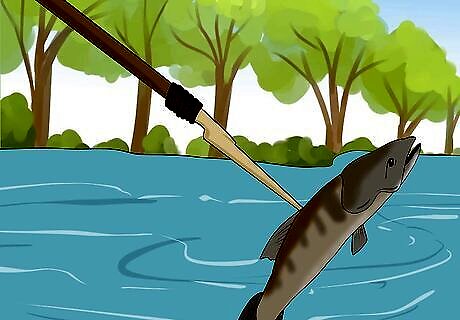
Jab your spear at the fish as they swim by. Aim for the base of the head where it connects with the body to kill the fish immediately. Pull the spear back to you with the fish hooked on the end once you have speared one. This will take a lot of practice and patience. You will also need to learn to adjust your aim because water refracts light and causes the fish to appear in a different location than that which they are actually in. You need to aim lower than you think you do, so shoot just under where it looks like the fish is.
Building a Net-in-the-Gap Trap

Find a narrow spot that water flows through. This can be a channel between 2 ponds or lakes, a narrow area of a stream, or where a small river flows into the ocean. Any narrow, moving area of water that you will be able to partially close off will work. This method is also known as weir fishing. It is a very old, tried-and-true method of catching fish by directing them to a certain area into a net or trap.
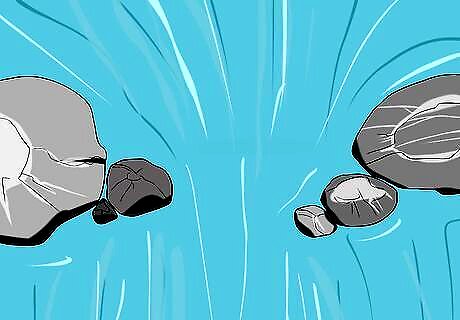
Block off the sides of the area with rocks in a “V” shape and leave a gap. Create a wall on each side so that the mouth of the V shape is facing upstream. This is now the only way through the area for fish to swim through. If there are no rocks, then you can use sticks and anything else you can find to create the walls. Make the gap slightly smaller than whatever you are going to place across it to catch the fish so that there is no room for fish to escape at the sides.
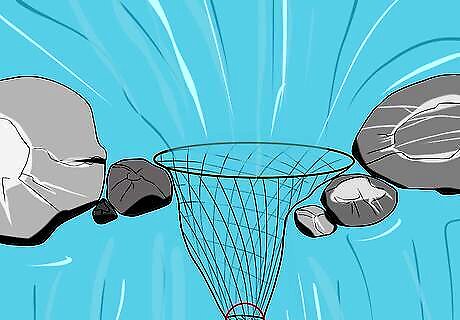
Place a net or plastic bag, downstream across the gap. Anchor it down with a rock on the inside. Use a stick to hold open the mouth of the net you are using if it doesn’t have a hard rim. This sets the trap for the fish to swim into.Tip: Alternatively, you can combine this method with spearfishing and wait for the fish to pass through the gap to spear them. You can improvise a net from clothing, blankets, or other fabric if you need to. Other things you can use include buckets or plastic bins. If you have a hand net, you could also stand and wait until you see fish passing through the gap and quickly scoop them up from the water.
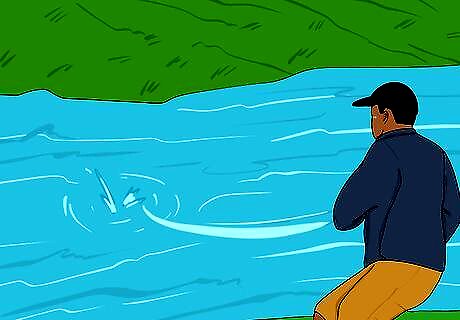
Make a commotion upstream to scare fish into the net. Throw rocks as far into the center as you can if your trap is downstream of a pond or lake. Beat the water with a branch or throw rocks upstream of your net. This is to encourage the fish to swim away from the commotion, down toward your trap. If you are not doing this alone, you can have someone stand down by your trap and watch for the fish to swim in. This way, you know when to stop and start making the commotion.

Go and check the trap after a few minutes of making a commotion. Quickly and carefully lift the net out of the water in a scooping motion, if there are any fish in it, and bring them to shore. Repeat making the commotion to try and scare fish into it until you catch some if there are none. You are most likely to catch several smaller fish with this method, rather than large fish. Large fish might be too strong for your net.













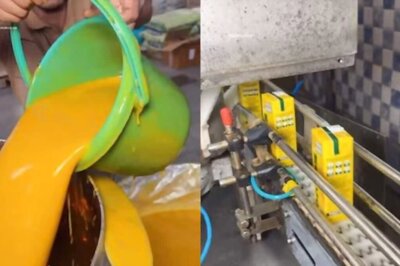






Comments
0 comment